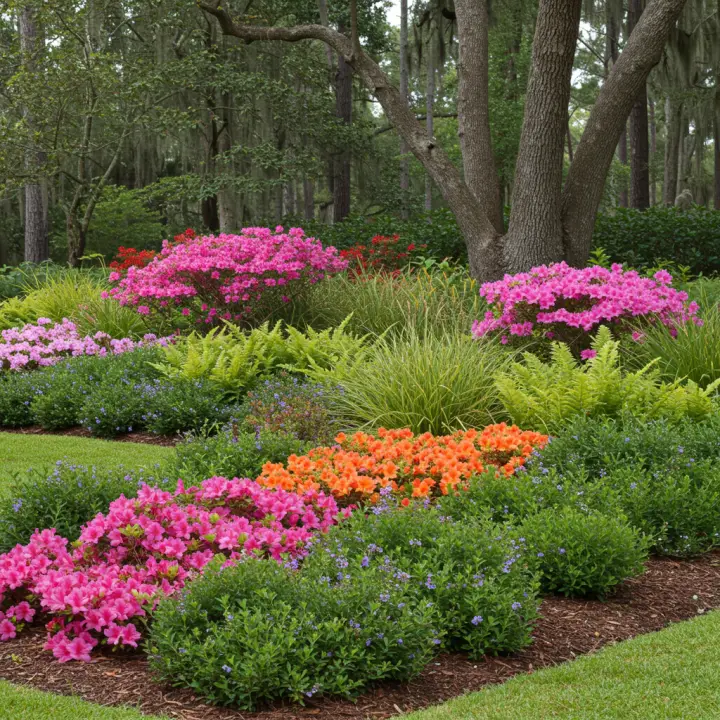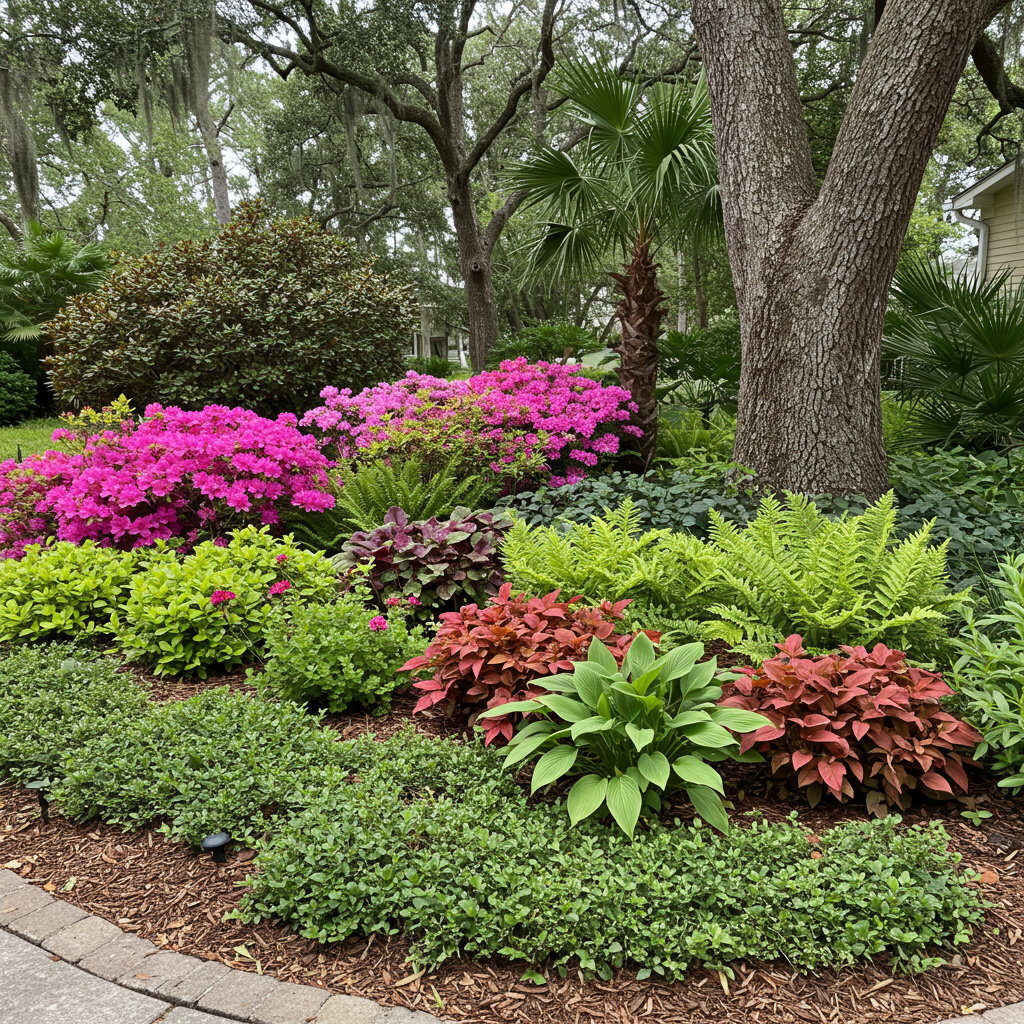Designing a vibrant, low-maintenance landscape in the Sunshine State doesn’t have to be a challenge. With the right selection of Northeast Florida plants, you can create a stunning garden that thrives effortlessly, saving you time, water, and money. This guide covers the best native and Florida-friendly trees, shrubs, perennials, and groundcovers that will transform your yard into a beautiful and resilient oasis.

Cultivating a Coastal Paradise: Why Choose Northeast Florida Plants?
Northeast Florida’s unique climate, characterized by hot, humid summers, mild winters, and sandy soils, demands a specific approach to landscaping. Choosing plants specifically suited for this region, including many fantastic native species, offers numerous benefits:
Drought Tolerance: Once established, many native and Florida-friendly plants require less supplemental irrigation, conserving water and reducing your utility bills.
Pest and Disease Resistance: These plants have evolved to thrive in local conditions, making them naturally more resilient to common pests and diseases, minimizing the need for chemical treatments.
Low Maintenance: Less watering, less pest control, and fewer special soil amendments mean more time enjoying your garden and less time working in it.
Supports Local Ecosystems: Native plants provide essential food and shelter for local wildlife, including pollinators like butterflies and bees, as well as birds.
Aesthetic Appeal: With a wide array of textures, colors, and forms, Northeast Florida plants can create genuinely stunning visual interest year-round.
Key Considerations for Northeast Florida Landscaping Success
Before you start digging, understanding your specific site conditions will help you choose the best plants.
Sun Exposure
Full Sun: Areas receiving 6+ hours of direct sunlight daily.
Partial Sun/Shade: Areas receiving 3-6 hours of sun, often morning sun.
Full Shade: Areas receiving less than 3 hours of direct sun.
Soil Type
Northeast Florida often has sandy, fast-draining soils. Some plants prefer this, while others might need organic matter added to improve water and nutrient retention. A soil test can provide valuable insights.
Watering & Irrigation
Even drought-tolerant plants need regular watering during their establishment period (typically 6-12 months). Consider efficient irrigation methods like drip systems.
Salt Tolerance (Coastal Areas)
If you live close to the coast, select plants that can tolerate salt spray and sandy, saline soils.
Stunning & Easy Northeast Florida Plants for Every Landscape Layer
Let’s explore some top choices for your garden, categorized by their growth habit.
H2: Majestic Trees: Providing Shade & Structure
Trees are the backbone of any landscape, offering shade, privacy, and year-round beauty.
Live Oak (Quercus virginiana): An iconic Florida native, known for its sprawling branches and evergreen foliage. Provides excellent shade and is incredibly resilient. Full sun, drought tolerant once established.
Southern Magnolia (Magnolia grandiflora): A classic with glossy green leaves and large, fragrant white blooms. Offers dense shade and an elegant look. Full sun to partial shade.
Crape Myrtle (Lagerstroemia indica): A popular choice for its vibrant summer flowers (white, pink, red, purple) and attractive shedding bark. Available in various sizes. Full sun, good drought tolerance and disease resistance.
Fringe Tree (Chionanthus virginicus): A beautiful native ornamental tree with delicate white, fragrant blooms in spring. Provides lovely seasonal interest. Full sun to partial shade.
Red Maple (Acer rubrum): Another native, offering stunning red foliage in autumn and attractive shape. Full sun to partial shade, prefers moist soil.
H2: Versatile Shrubs: The Mid-Layer Magic
Shrubs add definition, texture, and continuous color.
Azaleas (Rhododendron spp.): A quintessential Southern favorite. While some varieties require more care, many evergreen and deciduous types thrive in partial shade with acidic soil, producing spectacular spring blooms. Partial shade, moist acidic soil.
Indian Hawthorn (Rhaphiolepis indica): A tough, salt-tolerant evergreen with leathery leaves and clusters of pink or white flowers in spring, followed by dark berries. Excellent for hedges or mass plantings. Full sun to partial shade, very drought tolerant.
Podocarpus (Podocarpus macrophyllus): A dense, upright evergreen shrub or small tree, perfect for hedges, privacy screens, or formal plantings. Very adaptable and low maintenance. Full sun to partial shade, good drought tolerance.
Firebush (Hamelia patens): A fast-growing native shrub with tubular orange-red flowers that attract hummingbirds and butterflies. Offers continuous color from spring through fall. Full sun to partial shade, relatively drought tolerant.
Bottlebrush (Callistemon citrinus): Known for its unique, brush-like red flowers in spring and summer. Tolerant of various conditions, including some salt spray. Full sun, moderate drought tolerance.
H2: Colorful Perennials & Groundcovers: The Living Carpet
These plants add splashes of color and cover the ground beautifully, often requiring minimal care.
Lantana (Lantana camara): A superstar for continuous color, attracting butterflies. Available in many vibrant shades. Extremely drought and heat tolerant. Full sun, highly drought tolerant.
Coreopsis (Coreopsis lanceolata): Florida’s state wildflower! Produces abundant yellow, daisy-like flowers. Great for naturalized areas and attracts pollinators. Full sun, drought tolerant.
Salvia (Salvia spp.): Many varieties thrive here, offering spikes of red, blue, purple, or pink flowers that are irresistible to hummingbirds. Full sun, many are drought tolerant.
Fakahatchee Grass (Tripsacum floridanum): A beautiful native ornamental grass that adds texture and movement. Tolerates wet and dry conditions. Full sun to partial shade.
Liriope (Liriope muscari): A versatile, low-growing groundcover with grass-like foliage and purple flower spikes. Excellent for borders or mass plantings. Full sun to full shade, very adaptable.
Asiatic Jasmine (Trachelospermum asiaticum): A fast-spreading, evergreen groundcover with small, fragrant white flowers in spring. Excellent for covering large areas. Full sun to partial shade, relatively drought tolerant.
Designing Your Northeast Florida Landscape with Ease
Integrating these stunning and easy plants into your yard involves a few simple design principles:
Layering: Place taller plants (trees) in the back, medium-height plants (shrubs) in the middle, and low-growing plants (perennials, groundcovers) in the front.
Mass Planting: Plant groups of the same species together for a bolder visual impact and a more cohesive look.
Consider Bloom Times: Select plants that bloom at different times to ensure continuous color throughout the seasons.
Mind Your Microclimates: Pay attention to areas with more sun, shade, or moisture.
FAQ: Northeast Florida Plants
Q1: What are the best drought-tolerant plants for Northeast Florida?
A1: Excellent choices include Live Oak, Indian Hawthorn, Lantana, Coreopsis, and Salvia. Once established, these plants can tolerate periods of low rainfall with minimal supplemental watering.
Q2: Should I use native plants in my Northeast Florida landscape?
A2: Absolutely! Native plants are highly recommended because they are perfectly adapted to the local climate and soil, require less maintenance, and provide crucial support for local wildlife and pollinators.
Q3: When is the best time to plant in Northeast Florida?
A3: Fall (October-November) and early spring (March-April) are generally the best times. This allows plants to establish their root systems before the intense summer heat or potential winter cold snaps.
Q4: Do I need to fertilize my Northeast Florida plants?
A4: Many native and Florida-friendly plants are adapted to nutrient-poor sandy soils and require minimal fertilization. If you do fertilize, use a slow-release, granular fertilizer designed for your specific plant type and always follow package directions. Over-fertilizing can harm plants and the environment.
Q5: Where can I find these stunning Northeast Florida plants?
A5: Look for local nurseries that specialize in native or Florida-friendly plants. They can offer expert advice and ensure you’re getting plants well-suited for your specific area within Northeast Florida. University of Florida IFAS Extension offices are also excellent resources for plant recommendations.
Conclusion: Your Beautiful, Resilient Northeast Florida Landscape Awaits
Creating a breathtaking and low-maintenance landscape in Northeast Florida is entirely achievable by selecting the right Northeast Florida plants. From the majestic shade of a Live Oak to the vibrant hues of Lantana and Coreopsis, there’s a wealth of options that will thrive in our unique climate. By choosing Florida-friendly and native species, you’ll not only save time and resources but also contribute to a healthier local environment. Embrace the beauty of your region, and watch your garden flourish with stunning, easy-to-care-for plants.

